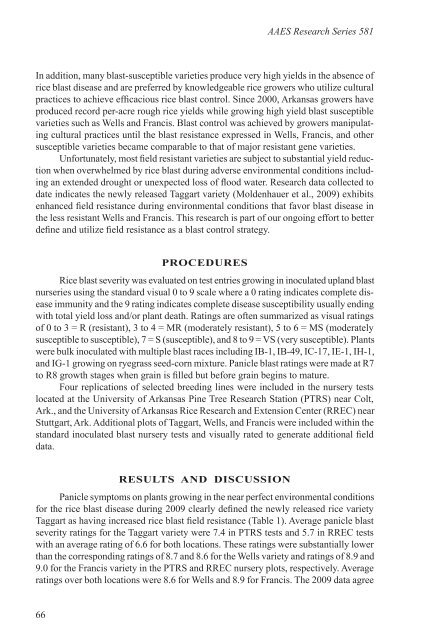'Taggart' Rice Variety Has Enhanced Blast Field Resistance
'Taggart' Rice Variety Has Enhanced Blast Field Resistance
'Taggart' Rice Variety Has Enhanced Blast Field Resistance
Create successful ePaper yourself
Turn your PDF publications into a flip-book with our unique Google optimized e-Paper software.
AAES Research Series 581In addition, many blast-susceptible varieties produce very high yields in the absence ofrice blast disease and are preferred by knowledgeable rice growers who utilize culturalpractices to achieve efficacious rice blast control. Since 2000, Arkansas growers haveproduced record per-acre rough rice yields while growing high yield blast susceptiblevarieties such as Wells and Francis. <strong>Blast</strong> control was achieved by growers manipulatingcultural practices until the blast resistance expressed in Wells, Francis, and othersusceptible varieties became comparable to that of major resistant gene varieties.Unfortunately, most field resistant varieties are subject to substantial yield reductionwhen overwhelmed by rice blast during adverse environmental conditions includingan extended drought or unexpected loss of flood water. Research data collected todate indicates the newly released Taggart variety (Moldenhauer et al., 2009) exhibitsenhanced field resistance during environmental conditions that favor blast disease inthe less resistant Wells and Francis. This research is part of our ongoing effort to betterdefine and utilize field resistance as a blast control strategy.PROCEDURES<strong>Rice</strong> blast severity was evaluated on test entries growing in inoculated upland blastnurseries using the standard visual 0 to 9 scale where a 0 rating indicates complete diseaseimmunity and the 9 rating indicates complete disease susceptibility usually endingwith total yield loss and/or plant death. Ratings are often summarized as visual ratingsof 0 to 3 = R (resistant), 3 to 4 = MR (moderately resistant), 5 to 6 = MS (moderatelysusceptible to susceptible), 7 = S (susceptible), and 8 to 9 = VS (very susceptible). Plantswere bulk inoculated with multiple blast races including IB-1, IB-49, IC-17, IE-1, IH-1,and IG-1 growing on ryegrass seed-corn mixture. Panicle blast ratings were made at R7to R8 growth stages when grain is filled but before grain begins to mature.Four replications of selected breeding lines were included in the nursery testslocated at the University of Arkansas Pine Tree Research Station (PTRS) near Colt,Ark., and the University of Arkansas <strong>Rice</strong> Research and Extension Center (RREC) nearStuttgart, Ark. Additional plots of Taggart, Wells, and Francis were included within thestandard inoculated blast nursery tests and visually rated to generate additional fielddata.RESULTS AND DISCUSSIONPanicle symptoms on plants growing in the near perfect environmental conditionsfor the rice blast disease during 2009 clearly defined the newly released rice varietyTaggart as having increased rice blast field resistance (Table 1). Average panicle blastseverity ratings for the Taggart variety were 7.4 in PTRS tests and 5.7 in RREC testswith an average rating of 6.6 for both locations. These ratings were substantially lowerthan the corresponding ratings of 8.7 and 8.6 for the Wells variety and ratings of 8.9 and9.0 for the Francis variety in the PTRS and RREC nursery plots, respectively. Averageratings over both locations were 8.6 for Wells and 8.9 for Francis. The 2009 data agree66
















